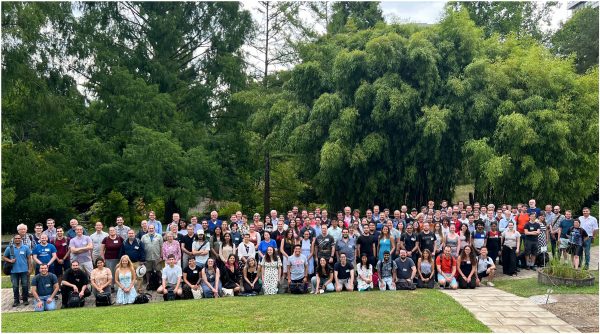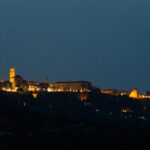July 11th, 2023 / Comments Off on VAM-2023 / by Vitaly
I attended the First Vasto Accretion Meeting (VAM2023) in Vasto (Italy) and have given the talk “Optically thin accretion discs in cataclysmic variables with a low mass-transfer rate”. The slides (as well as other presentations of the conference) can be downloaded from here (my file is in the Friday’s folder).

Posted in: Astronomy, Conferences, Work
Tags: Conferences, News
March 2nd, 2023 / Comments Off on MNRAS goes open access / by Vitaly
Not good news. The Royal Astronomical Society has just announced that all authors publishing in MNRAS will soon have to pay page charges.

Posted in: Astronomy, Publications, Work
Tags: News
February 25th, 2023 / Comments Off on Happy MJD60000! / by Vitaly
In observational astronomy, in order not to have problems with months and leap years, the time is counted in Julian days. The Julian day (JD) is the continuous count of days since the beginning of the Julian period, Greenwich noon on January 1, 4713 BC, until the given time. For almost my entire career, this number has been like JD245####. The number is long, so in my papers, I usually use only the last 4 digits, a kind of unofficial format. But there is an official format, Modified Julian Day (MJD), which is MJD=JD-2400000.5
Well, today my format stopped working because today is MJD 60000!

Posted in: Astronomy, Observations, Work
Tags: News
December 21st, 2022 / Comments Off on MAGIC paper accepted in Physical Review Letters / by Vitaly
Search for Gamma-ray Spectral Lines from Dark Matter Annihilation up to 100 TeV towards the Galactic Center with MAGIC.
arXiv:2212.10527
Line-like features in TeV γ-rays constitute a “smoking gun” for TeV-scale particle dark matter and new physics. Probing the Galactic Center region with ground-based Cherenkov telescopes enables the search for TeV spectral features in immediate association with a dense dark matter reservoir at a sensitivity out of reach for satellite γ-ray detectors, and direct detection and collider experiments. We report on 223 hours of observations of the Galactic Center region with the MAGIC stereoscopic telescope system reaching γ-ray energies up to 100 TeV. We improved the sensitivity to spectral lines at high energies using large-zenith-angle observations and a novel background modeling method within a maximum-likelihood analysis in the energy domain. No line-like spectral feature is found in our analysis. Therefore, we constrain the cross section for dark matter annihilation into two photons to ⟨σv⟩≲5×10−28 cm3 s−1 at 1 TeV and ⟨σv⟩≲1×10−25 cm3 s−1 at 100 TeV, achieving the best limits to date for a dark matter mass above 20 TeV and a cuspy dark matter profile at the Galactic Center. Finally, we use the derived limits for both cuspy and cored dark matter profiles to constrain supersymmetric wino models.

Posted in: Astronomy, MAGIC, Publications
Tags: News
December 6th, 2022 / Comments Off on R.I.P. Tom Marsh (1961-2022) / by Vitaly
I was deeply shocked by the terrible news about the mysterious disappearance of Tom Marsh just a few weeks after our last meeting in August. Almost every day I checked different internet sources hoping to find good news before the tragic one appeared about finding his body.
I first learned about Tom in the late 1980s when I was a student working on modeling double-peaked profiles of emission lines from accreting discs. I was thrilled about the prospect of a new method of Doppler tomography, developed by Tom Marsh and Keith Horne in 1988. Since then I started reading all of Tom’s papers. He was a great and inspirational scientist.
I first met Tom in person in June of 1998, when we both attended the Summer School “Astrophysical Discs” in Cambridge, Tom was a lecturer, and I was a participant. I was impressed that he was always surrounded by young colleagues with whom he generously shared his vast knowledge. Since then, we have met many times at different conferences and also on La Palma, where Tom often observed.
I wish I had the opportunity to work with Tom closer, but I’m glad that I had the privilege to collaborate with Tom on several projects. The last time we had a long discussion was in August in Tuebingen, just a few weeks before Tom’s disappearance.
I send my deepest condolences to Tom’s family and friends. This is a great loss to all of us but he will remain in our hearts forever. May you rest in peace, Tom.


Posted in: Astronomy, Blog, Official, Work
Tags: News, Official
August 30th, 2022 / Comments Off on EUROWD22: 22nd European Workshop on White Dwarfs / by Vitaly
I have just come back from a research visit to Tübingen, Germany, where I also attended the 22nd European Workshop on White Dwarf. I have given the talk “On the determination of fundamental parameters of accreting white dwarfs” which can be downloaded from here.


Posted in: Astronomy, Conferences, Work
Tags: Conferences, News, Photo
April 19th, 2022 / Comments Off on MAGIC paper in Nature Astronomy on the recurrent nova RS Oph explosion / by Vitaly
MAGIC collaboration published a paper in Nature Astronomy “Proton acceleration in thermonuclear nova explosions revealed by gamma rays”. For the first time, the gamma-ray emission from the recurrent nova RS Oph in the 60 GeV to 250 GeV energy range has been accurately characterized. Another interesting finding is that during nova explosions bubbles of enhanced cosmic-ray density can be created. Such protons will add to the Galactic cosmic ray budget, although primarily in the close neighbourhood of novae (of the order of 10 pc from the recurrent novae).
ArXiv: https://arxiv.org/abs/2202.07681
Link to the published paper: https://www.nature.com/articles/s41550-022-01640-z

Posted in: Astronomy, Discovery, MAGIC, Publications, Work
Tags: News
March 1st, 2022 / Comments Off on Joint Letter Against the War in Ukraine of the Russian Scholars Working in Finland / by Vitaly
WE, Russian scientists and researchers, working in Finnish universities stand in solidarity with our Ukrainian colleagues, their families, Ukraine, and all the people who oppose the war. We declare a strong protest against the war with Ukraine. We call to end this war immediately!
We find no justification for the invasion and utterly condemn this unprovoked military assault. We reject Vladimir Putin’s distorted historical revisionism, myths and cynical lies that deny the right to self-determination of the Ukrainian nation and justify Russia’s imperialism. We condemn the Kremlin’s horrific misinformation campaign as well as Putin’s misrepresentation of Holocaust history to justify the war.
No to war in Ukraine! Putin’s war against Ukraine must be stopped!
Read the full statement here
Коллективное письмо российских ученых, работающих в Финляндии и выступающих против войны в Украине
МЫ, российские ученые и исследователи, работающие в финских университетах, солидарны с нашими украинскими коллегами, их семьями, Украиной и всеми людьми, которые выступают против войны. Мы заявляем решительный протест против войны с Украиной. Мы призываем немедленно прекратить эту войну!
Мы не находим оправдания вторжению и категорически осуждаем ничем не спровоцированную войну. Мы отвергаем искаженный исторический ревизионизм, мифы и циничную ложь Владимира Путина, отрицающие право на самоопределение украинской нации и оправдывающие российский империализм. Мы осуждаем ужасную кампанию Кремля по дезинформации, а также искажение Путиным истории Холокоста для оправдания войны.
Нет войне в Украине! Война Путина против Украины должна быть остановлена!
Read the full statement here
Tämä on Suomessa toimivien venäläisten tutkijoiden avoin kirje Ukrainan sotaa vastaan.
ME Suomessa toimivat ja asuvat venäläiset tutkijat olemme solidaarisia ukrainalaisille kollegoillemme, heidän perheilleen, Ukrainalle, sekä kaikille sotaa vastustaville ihmisille. Vastustamme kaikin keinoin sotaa Ukrainassa. Vaadimme, että sotatoimet on lopetettava välittömästi!
Me emme löydä minkäänlaista oikeutusta miehitykselle, ja tuomitsemme täysin provosoimattoman aseellisen hyökkäyksen. Hylkäämme Vladimir Putinin historian vääristelyn, myytit ja kyyniset valheet, jotka kieltävät Ukrainan kansalta itsemääräämisoikeuden ja pyrkivät oikeuttamaan Venäjän imperialismia. Tuomitsemme Kremlin valheisiin perustuvan disinformaatiokampanjan ja Putinin vääristyneen tulkinnan holokaustin historiasta sodan oikeutuksen keinona.
Ei sodalle Ukrainassa! Putinin sota Ukrainaa vastaan täytyy pysäyttää!
Read the full statement here

Posted in: Official, Politics
Tags: News, Official
December 15th, 2021 / Comments Off on Swift follow-up observations of AT2021afpi / MASTER OT J030227.28+191754.5 / by Vitaly
ATel #15115 (15 Dec 2021): V. V. Neustroev (U. Oulu), J. P. Osborne (U. Leicester), K. L. Page (U. Leicester)
We report the results of follow-up observations of AT2021afpi = MASTER OT J030227.28+191754.5 carried out with the Neil Gehrels Swift Observatory. The object was discovered on 2021 November 27 as a bright optical transient by MASTER (ATel #15067) as a result of follow-up observations of the IceCube neutrino alert IceCube-211125A (GCN #31126). However, it has been shown (ATel #15081) that AT2021afpi started brightening at least 8.5 hours before the IceCube-211125A trigger (November 24, 21:53 UT). Based on the large amplitude of the optical outburst (~10 mag), the transient was initially classified as a classical nova (ATel #15069). Nevertheless, the following optical spectroscopic and time-resolved photometric observations have confirmed that AT2021afpi is a very high amplitude WZ Sge-type dwarf nova (ATel #15072, #15074).
Swift started monitoring AT2021afpi 3.9 days after the transient discovery. Although initially bright, with an XRT count rate ~1.1 c/s (ATel #15073, #15087), AT2021afpi has rapidly faded for ~10 days before stabilizing at ~0.02 c/s on December 4-5. On December 11, the X-ray flux dropped to the level of about ~0.005 c/s, but returned back to the level of ~0.02 c/s by the time of the next observation on December 13. However, the optical and UV light curves show only a smooth slow decline and no response to this X-ray drop. So far, the X-ray and UV flux evolution of AT2021afpi is similar to that of the superoutbursts of SSS J122221.7-311525 and GW Lib (Neustroev+18 A&A 611 13).
An X-ray spectrum consisting of the data with the lowest XRT count rates < 0.03 c/s is also consistent with the outburst spectra of SSS J122221.7-311525 and GW Lib. It can be satisfactorily fitted with one optically thin emission component. However, the two first Swift/XRT observations show the presence below 0.8 keV of an additional strong soft component. Thus, 2 optically-thin components are needed for a satisfactory fit of these "higher-state" data (see also ATel #15087).
We thank the Swift PI, Brad Cenko, for approving the observations, and the Swift planning and operations teams for their ongoing support.

Posted in: Astronomy, Observations, Publications, Work
Tags: ATel, News
April 16th, 2021 / Comments Off on A unified look at a famous black hole in M87 / by Vitaly
In April 2019, scientists released the first image of a black hole in the galaxy M87 using the Event Horizon Telescope (EHT). Now data from nineteen observatories, including MAGIC, are being released that promise to give unparalleled insight into this black hole and the system it powers, and to improve tests of Einstein’s General Theory of Relativity. See the full press release of the EHT here.
The paper entitled “Broadband Multi-wavelength Properties of M87 during the 2017 Event Horizon Telescope Campaign” is just accepted in ApJ Letters (arXiv:2104.06855):
Abstract:
In 2017, the Event Horizon Telescope (EHT) Collaboration succeeded in capturing the first direct image of the center of the M87 galaxy. The asymmetric ring morphology and size are consistent with theoretical expectations for a weakly accreting supermassive black hole of mass approximately 6.5 x 10^9 M_solar. The EHTC also partnered with several international facilities in space and on the ground, to arrange an extensive, quasi-simultaneous multi-wavelength campaign. This Letter presents the results and analysis of this campaign, as well as the multi-wavelength data as a legacy data repository. We captured M87 in a historically low state, and the core flux dominates over HST-1 at high energies, making it possible to combine core flux constraints with the more spatially precise very long baseline interferometry data. We present the most complete simultaneous multi-wavelength spectrum of the active nucleus to date, and discuss the complexity and caveats of combining data from different spatial scales into one broadband spectrum. We apply two heuristic, isotropic leptonic single-zone models to provide insight into the basic source properties, but conclude that a structured jet is necessary to explain M87’s spectrum. We can exclude that the simultaneous gamma-ray emission is produced via inverse Compton emission in the same region producing the EHT mm-band emission, and further conclude that the gamma-rays can only be produced in the inner jets (inward of HST-1) if there are strongly particle-dominated regions. Direct synchrotron emission from accelerated protons and secondaries cannot yet be excluded.

Posted in: Astronomy, MAGIC, Publications, Work
Tags: News, Official



















